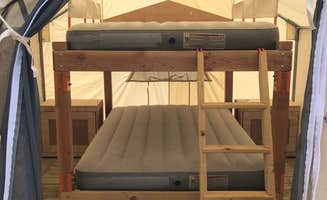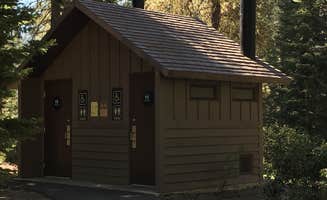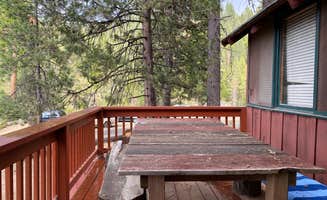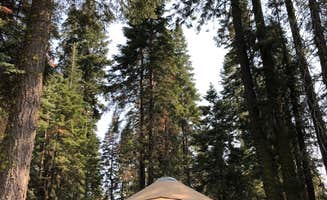Camping and glamping options surrounding Woodlake, California range from 400 to 7,500 feet in elevation, creating distinct climate zones and camping experiences. The area sits at the western edge of Sequoia National Forest, with summer temperatures reaching 95-100°F in lower elevations while higher-elevation sites maintain cooler 70-80°F daytime temperatures. Most campgrounds near Woodlake require reservations between May and September, with first-come sites filling by Thursday afternoon during summer months.
What to do
Riverside exploration: Horse Creek Campground offers access to water activities when lake levels permit. "When the lake is full you can walk right up to the waters edge and actually boat in for camping," explains Rob E., though conditions vary seasonally. During drought periods, campers may need to adjust expectations, as "we had to drive 3 miles up where the river flows to cool down," according to fabricio M.
Sequoia viewing: Princess Campground provides accessible giant sequoia experiences. "There are sequoia stumps spread throughout the entire campground and adjacent meadow," notes one visitor. The campground features "a lovely paved trail near the adjacent meadow and sequoia grove" where interpretive signs explain forest history. Families especially enjoy the "walking trail right outside of camp through a beautiful meadow."
Swimming: Pine Flat Campground offers lake access during warm summer months. "We had a blast on my kayak and with my dogs and trying to catch fish," shares Casey. The area features "trails to hike and explore" alongside water recreation opportunities. Lakeside camping provides unique soundscapes, where "you'll hear all the frogs by night and birds in the morning," making it "a great place for fly fishing or cat fishing."
What campers like
Natural swimming areas: Buckeye Flat Campground offers tent camping with river access. "There is access to the river for a cooling dip," notes James W., making it a popular spot during hot summer days. The campground's layout "maintained a feeling of privacy" despite being somewhat crowded during peak periods, according to Amanda P.
Dark sky stargazing: Tenmile Campground provides dispersed camping with minimal light pollution. The free sites feature "a man made fire ring with plenty of log seating around it," according to Mandy. The campground's location makes it "a great spot to use as a base for hiking," with Jillian noting its prime position for exploring both Sequoia and Kings Canyon.
Wildlife viewing: Camping near Woodlake offers opportunities to observe local wildlife in natural settings. At Horse Creek Campground, "bats at night really helped with the bug problem and created a cool ambience while stargazing. My husband loved listening to them hunt!" At other sites, visitors report seeing deer, coyotes, and various bird species, though proper food storage remains essential as "there are bears (though I didn't see any)."
What you should know
Amenity variability: Sentinel Campground provides standard national park facilities with seasonal limitations. "Basic bathrooms, no showers. Small store/rangers office and maybe a small eatery open in peak season throughout the day," explains Bryan R. The campground features "plenty of bathrooms, water spigots, and trash/recycling bins," though services become "very limited after dark throughout the Sierra Nevada park systems."
Site selection: Campsites throughout the region vary significantly in size, privacy, and layout. At Princess Campground, "sites are spacious, offer plenty of privacy, and have large tables and firepits." Conversely, at Sunset Campground, "sites are pretty close together" and "the sites are extremely close together. So be prepared to get to know your neighbor."
Seasonal road challenges: High-elevation camping requires preparation for mountain driving conditions. "Due to the elevation, always bring chains with y'all, there are some places there that rents or buy the chain but it could be really pricey," advises Joan F. Winter access becomes limited or impossible at many sites, and some campgrounds close entirely after the first snowfall.
Tips for camping with families
Natural playgrounds: Many campgrounds feature fallen trees and natural features that entertain children. At Sentinel Campground, "there was a small stream at the back of the site that occupied kids making fairy houses for hours," shares Emily B. Similarly, Princess Campground has "a big stump the kids played on" making it a "family friendly campground" with natural attractions.
Noise considerations: Family camping experiences vary by campground. Pine Flat gets described as a "family camp. If you not offended by noisy kids, you can stay here," while quieter options exist at higher elevations where camp hosts "keep the facilities super clean, it's quiet at night even with a full campground."
Bear awareness: Teaching children about wildlife safety remains essential. "This is an active bear area, and all rules apply," notes Bryan R. Campgrounds provide "bear boxes to store your food or other gear that might be odorous" and rangers regularly patrol to ensure compliance with food storage regulations.
Tips from RVers
Site leveling: RV campers should prepare for uneven terrain at many campgrounds. At Horse Creek Campground, "Nearly every campsite has a major hill, so most will not have a good flat area for a tent," reports Brittney J. Even at established campgrounds, Connor N. notes that "sites were generally not level as it is situated on the hill down to the lake."
Dump station availability: RV services fluctuate seasonally. "The RV Dump station was also unavailable" due to maintenance at certain times, while during off-seasons, some campgrounds offer free access to "use the RV sewer cleanout and water fill-up station" that normally costs $10.
Size restrictions: Larger RVs face limitations at most glamping sites near Woodlake. At Lindy's Landing, "if you have a big trailer, don't get these spots at the end (L-28)" as maneuvering becomes challenging with "a huge concrete barrier" and "chain link fence in the way." Smaller 25-foot travel trailers generally navigate these campgrounds more easily than large fifth wheels exceeding 35 feet.






